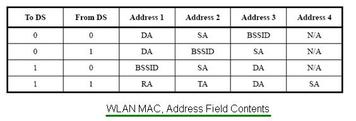IEEE 802.11 Standards: A Comprehensive Comparison
Advertisement
This page provides a comparison of various IEEE 802.11 standards, specifically 802.11e, 11f, 11h, 11i, 11j, 11k, 11m, 11p, 11r, 11w, 11u, and 11x. We will outline the key features and differences between these standards.
IEEE 802.11 Standards: Features and Differences
| 802.11 Standard | Features |
|---|---|
| IEEE 802.11e | Adds Quality of Service (QoS) features to the 802.11 standard family, allowing for prioritization of different types of network traffic. |
| IEEE 802.11f | Adds interoperability between Access Points (APs) to existing IEEE 802.11 standards, enabling seamless transitions between APs. |
| IEEE 802.11h | Addresses interference-related issues in existing 802.11 implementations by introducing features like Dynamic Frequency Selection (DFS) and Transmit Power Control (TPC). |
| IEEE 802.11i | Improves the security of existing 802.11a/11b/11g-based networks. It introduces stronger encryption protocols such as TKIP (Temporal Key Integrity Protocol) and AES (Advanced Encryption Standard). |
| IEEE 802.11j | Provides Japanese extensions to the existing 802.11a version. Modulation: OFDM, Bandwidth: 10MHz, 20MHz, Data rate: 3-27Mbps, 6-54Mbps, Frequency channels: Additional channels in the 4.9-5GHz bands. |
| IEEE 802.11k | Adds Radio Resource Measurement (RRM) for 802.11-based products to make WLAN networks more efficient by enabling network devices to collect and report information about the radio environment. |
| IEEE 802.11m | Adds enhancements to existing maintenance features, improves, and amends 802.11 protocols, focusing on improving the accuracy and efficiency of the maintenance procedures. |
| IEEE 802.11p (WAVE) | Amends the existing 802.11 standard to provide wireless access in vehicular environments (WAVE). Channel spacings of 5MHz, 10MHz, and 20MHz are added to the 5.9GHz frequency band. 802.11p is used for data communication among vehicles (V2V) and between vehicles & road-side infrastructure (V2I). It supports a coverage range of 1 km with 3-27 Mbps data rate with a velocity of 260Km/h. It is used for car-to-car communication. |
| IEEE 802.11r | Provides fast roaming capabilities. This version introduces a new roaming concept where a handshake with the new Access Point (AP) is made before the client (STA) actually moves to the target AP area. This is known as Fast Transition roaming or FT roaming. This handshake concept allows prior PTK (Pairwise Transient Key) calculation between the client and APs. |
| IEEE 802.11w | Increases the security of 802.11 management frames (class 1, class 2, and class 3). IEEE 802.11w standard has added a new IGTK Key, which is used to protect broadcast as well as multicast robust management WLAN frames. |
| IEEE 802.11u | Is an amendment to the IEEE 802.11-2007 standard. It enhances the capabilities of Wi-Fi networks and specifies interworking with other external networks. “Hotspot 2.0” is the product name as per 802.11u, given by the Wi-Fi Alliance. |
| IEEE 802.11x | This abbreviation is used as a general term for all the IEEE 802.11 family of protocols, where the letter ‘x’ represents various suffix letters such as ‘a’, ‘b’, ‘g’, ‘n’, ‘ac’, ‘ad’, ‘e’, ‘f’, ‘h’, ‘i’, ‘j’, ‘k’, ‘m’, ‘p’, ‘r’, ‘w’, etc. |
The IEEE standard 802.1X is a port-based Network Access Control (NAC) which allows administrators to provide restricted use of WLAN SAPs. This 802.1X helps network administrators to provide secured communication between authorized & authenticated WLAN devices.
Advertisement
 RF
RF







